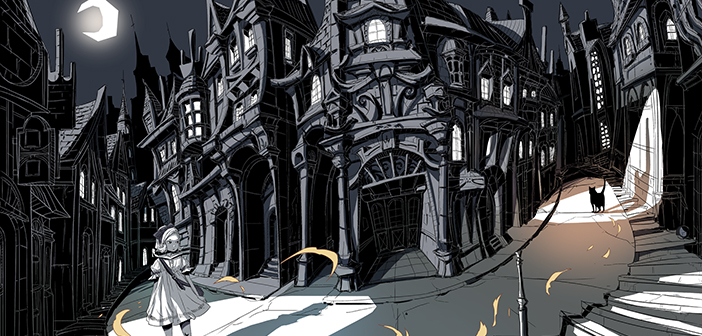Games that use shadows as a key aspect of the game design aren’t exactly a rarity, from the shadow-based platforming of Contrast to the shadow puppet puzzles of Shadowmatic, but it’s still a concept with so much untapped potential. Case in point: NEXT Studios’ Iris.Fall, a game that brings its own take on familiar shadow-puzzle ideas and combines them with a gorgeous monochrome art style and fascinating set design, making for a captivating game.
Iris.Fall follows Iris, a young girl who awakes from a dream to find herself inside a strange, dilapidated theatre. In pursuit of a mysterious black cat and (hopefully) a way out, she finds herself faced with all manner of strange rooms full of MC Escher-like architecture and curious puzzles, the solving of which depends on her ability to move from the 3D world to the 2D one of shadows cast upon the world.
Moving objects about in the 3D world changes the shadow that they cast, thus creating new paths for shadow Iris to traverse. She can’t freely switch forms, but rather uses special portals—marked by glowing piles of books—and so figuring out how to combine those portals and the shadow paths is the crux of Iris.Fall‘s puzzle solving.

From that basis, Iris.Fall finds plenty of creative ways to build on the theme. Perspective puzzles, shadow puppets, adventure game-style item puzzles, machinery manipulation, and picture puzzles—to name but a few—all come into the mix, with clever light-and-shadow twists. Even in the space of a few hours, give it take, Iris.Fall manages to take its core ideas in a wide range of different directions.
This makes for a consistently satisfying puzzle solving. Iris.Fall rarely gets overly difficult, but still manages to keep its puzzle interesting even when they verge on the easy side. They’re complex enough to not be boring, and to engage the brain in a meaningful way, but don’t often feel like a nuisance or a roadblock. There is the occasional head-scratcher that can become frustrating depending on your level of patience, for the most part, Iris.Fall‘s puzzles are logical without being obtuse. That can be a difficult balance to get right.
These puzzles also lend themselves to a surreal atmosphere that drives Iris.Fall‘s storytelling. There’s an Alice’s Adventures in Wonderland vibe to the whole thing, from the dreamlike world, to the character design of Iris herself, to the mischievous role that the black cat plays—a cheshire cat in energy, if not in look. As Iris delves deeper into the theatre, things grow increasingly bizarre, especially when her shadow seems to take on a life of its own.

It’s the setup for the sort of abstract character exploration that puzzle games like this are so well-equipped to handle. Iris.Fall is an abstract delve into the mind of a young girl, personified in this theatre that defies all laws of physics and in the puzzles that Iris has to solve to find her way forward. With light and shadow as a central theme, and recurring motifs of puppets, stage props, and other such objects from the world of theatre, all the pieces are there for a thoughtful reflection on Iris—both who she is, and what she represents.
Unfortunately, it’s potential that Iris.Fall never really delivers on. I’m all for abstract, non-linear storytelling that puts theme and emotion ahead of a cohesive and easily-understood plot (see my thoughts on Sunlight, for example), but substance and context is crucial. Iris.Fall delivers on the abstract, open-to-interpretation quality—sometimes to a fault—but it doesn’t have the depth to go with it. It amounts to a commentary on screen-time and children, but without the nuance that this sort of theme needs to elicit anything more than an eye-roll. It’s the “Books were the original handheld device” quip that you sometimes see on chalkboards outside bookshops, but—somewhat ironically—in the form of a videogame.
But for all its lack of depth, Iris.Fall is a gorgeous looking game. In keeping with the theme of light and shadows, it uses an almost entirely monochrome palette, bringing to the surface a level of detail that’s easily to overlook with something in full colour. There are still splashes of colour in key moments, but used deliberately and with restraint to draw focus to specific things. A cel-shaded finish gives the whole game a hand-animated look, almost like illustrations from a picture book brought to life. It’s an effect that works especially well for the detailed, surreal scenery decorating each room.

Iris.Fall continues the trend of shadow-based puzzle games, finding plenty of opportunity to build on the core concept of moving 3D objects to create paths among the shadows cast. It doesn’t quite hit the mark with the sort of introspective, abstract storytelling it tries to deliver, but its clever puzzles and stunning presentation nonetheless make Iris.Fall a few hours well spent.

Iris.Fall is developed by NEXT Studios and published by PM Studios. It’s available now for Nintendo Switch (reviewed), PlayStation 4, Xbox One, and PC.
A review copy was provided to Shindig by the publisher.

